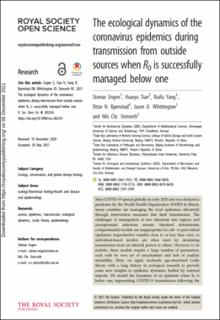| dc.contributor.author | Engen, Steinar | |
| dc.contributor.author | Tian, Huaiyu | |
| dc.contributor.author | Yang, Ruifu | |
| dc.contributor.author | Bjørnstad, Ottar Nordal | |
| dc.contributor.author | Whittington, Jason | |
| dc.contributor.author | Stenseth, Nils Christian | |
| dc.date.accessioned | 2022-02-28T14:36:46Z | |
| dc.date.available | 2022-02-28T14:36:46Z | |
| dc.date.created | 2021-08-10T11:58:04Z | |
| dc.date.issued | 2021 | |
| dc.identifier.citation | Royal Society Open Science. 2021, 8 (6), 1-12. | en_US |
| dc.identifier.issn | 2054-5703 | |
| dc.identifier.uri | https://hdl.handle.net/11250/2981803 | |
| dc.description.abstract | Since COVID-19 spread globally in early 2020 and was declared a pandemic by the World Health Organization (WHO) in March, many countries are managing the local epidemics effectively through intervention measures that limit transmission. The challenges of immigration of new infections into regions and asymptomatic infections remain. Standard deterministic compartmental models are inappropriate for sub- or peri-critical epidemics (reproductive number close to or less than one), so individual-based models are often used by simulating transmission from an infected person to others. However, to be realistic, these models require a large number of parameters, each with its own set of uncertainties and lack of analytic tractability. Here, we apply stochastic age-structured Leslie theory with a long history in ecological research to provide some new insights to epidemic dynamics fuelled by external imports. We model the dynamics of an epidemic when R0 is below one, representing COVID-19 transmission following the successful application of intervention measures, and the transmission dynamics expected when infections migrate into a region. The model framework allows more rapid prediction of the shape and size of an epidemic to improve scaling of the response. During an epidemic when the numbers of infected individuals are rapidly changing, this will help clarify the situation of the pandemic and guide faster and more effective intervention. | en_US |
| dc.language.iso | eng | en_US |
| dc.publisher | Royal Society of Chemistry | en_US |
| dc.rights | Navngivelse 4.0 Internasjonal | * |
| dc.rights.uri | http://creativecommons.org/licenses/by/4.0/deed.no | * |
| dc.title | The ecological dynamics of the coronavirus epidemics during transmission from outside sources when R0 is successfully managed below one | en_US |
| dc.type | Peer reviewed | en_US |
| dc.type | Journal article | en_US |
| dc.description.version | publishedVersion | en_US |
| dc.source.pagenumber | 1-12 | en_US |
| dc.source.volume | 8 | en_US |
| dc.source.journal | Royal Society Open Science | en_US |
| dc.source.issue | 6 | en_US |
| dc.identifier.doi | 10.1098/rsos.202234 | |
| dc.identifier.cristin | 1924989 | |
| dc.relation.project | Norges forskningsråd: 312740 | en_US |
| cristin.ispublished | true | |
| cristin.fulltext | original | |
| cristin.qualitycode | 1 | |

